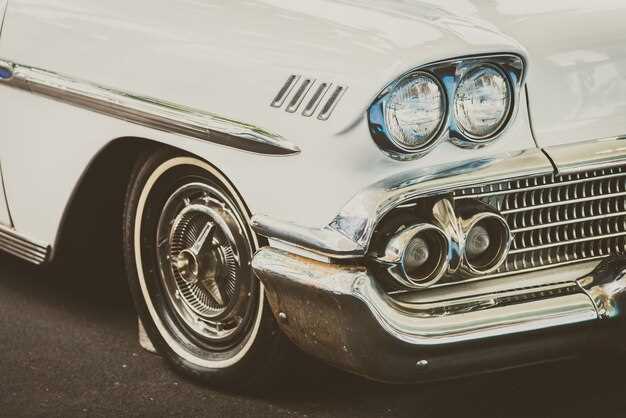
As we approach 2025, the world of investing continues to evolve, prompting many to reassess their portfolios and consider alternative assets. Among these, classic cars have emerged as compelling options for both automobile enthusiasts and savvy investors. The appeal of vintage vehicles lies not only in their aesthetic charm but also in their potential for substantial appreciation over time.
Investing in classic cars offers unique advantages, distinguishing them from traditional financial assets. Unlike stocks and bonds, vintage vehicles can provide tangible returns, allowing collectors to enjoy their investments while watching their value grow. With the right models, condition, and provenance, collectors can unlock significant financial gains, making classic cars an attractive asset class as we enter a new decade.
Factors like market trends, rarity, and historical significance play crucial roles in determining the investment potential of specific classic cars. As we delve deeper into this topic, we will examine the key indicators that suggest vintage automobiles could be a smart investment for the future, providing insights into both the risks and rewards associated with this passionate pursuit.
Assessing the Current Market Trends for Vintage Cars in 2025

As we move into 2025, the vintage car market exhibits distinct trends that potential investors should consider. Understanding these dynamics is crucial when contemplating investing in classic vehicles.
- Growing Demand: The interest in vintage cars continues to rise. Enthusiasts and collectors are increasingly drawn to the unique qualities of classic models, contributing to a competitive market.
- Investment Potential: Vintage cars are often regarded as alternative investments. Their value can appreciate significantly over time, making them an attractive option for those seeking to diversify their portfolios.
- Digital Platforms: Online auctions and marketplaces have transformed how classic cars are bought and sold. This accessibility enhances liquidity in the market, allowing investors to tap into a broader audience.
- Condition and Rarity: The condition of a vintage vehicle remains a critical factor in value determination. Rarer models with well-documented histories tend to command higher prices. Investors should focus on acquiring examples in excellent condition.
- Carbon Footprint and Sustainability: The push for environmentally friendly solutions is influencing trends in the automotive industry. Vintage electric conversions are gaining popularity, potentially offering new investment avenues.
In summary, the vintage car market in 2025 appears to be robust, driven by rising demand and innovative buying avenues. Investors should actively analyze detailed market reports, focusing on specific makes and models that demonstrate a history of appreciation in value.
- Monitor Classic Car Auctions: Stay informed about sales and trends in high-profile auctions.
- Join Vintage Car Clubs: Engage with fellow enthusiasts to gain insights and networking opportunities.
- Research: Study past trends to predict future movements and identify potential investment opportunities.
Cautious and informed investing in the vintage car market can yield rewarding results for those who navigate the landscape wisely.
Key Factors Influencing the Value of Classic Cars for Future Investment
The value of classic cars as an investment hinges on several key factors that potential investors should consider. One of the primary determinants is rarity. Limited production models or unique vehicles tend to appreciate significantly due to their scarcity in the market. Collectors often seek out these rare finds, driving up their value over time.
Another crucial factor is the condition of the car. Well-preserved vehicles with original parts and low mileage generally command higher prices. Restoration quality also plays a significant role; cars that are expertly restored can fetch impressive premiums compared to those in mediocre condition.
Historical significance is equally important. Cars associated with notable events, personalities, or brands often attract enthusiasts willing to pay a premium. This historical context adds a narrative that can enhance the vehicle’s desirability and, subsequently, its value.
Market trends should not be overlooked. The demand for certain models can fluctuate based on cultural interests, economic conditions, and collector preferences. Staying informed about market dynamics can help investors make strategic choices regarding what models to acquire and when to sell.
Ultimately, provenance and documentation also influence value. A car with a well-documented history, including ownership records and service history, reassures buyers about its authenticity and condition, making it a more attractive investment.
Practical Tips for Investing in Vintage Cars: What to Look For

Investing in vintage cars can be rewarding, but it requires careful consideration. To ensure you make a wise investment, pay attention to the following factors:
1. Research the Market: Start by understanding the classic car market. Identify which models are in demand and their historical appreciation rates. Resources like auction results and classic car magazines can provide valuable insights.
2. Condition of the Vehicle: Assess the overall condition of the car. Look for signs of rust, mechanical issues, and the state of the interior. A well-maintained vehicle typically holds its value better.
3. Provenance and History: Investigate the car’s history. Documented provenance, including previous ownership and service records, can enhance its value. Cars with unique stories or celebrity ownership tend to have higher appeal.
4. Original Parts vs. Aftermarket: Preserving the originality of a classic car is crucial. Ensure that the vehicle contains original parts, as modifications can affect its market value. If modifications exist, keep records of the changes made.
5. Rarity and Production Numbers: Limited production models often appreciate more than those that are mass-produced. Research how many units were made and how many are still in existence to gauge rarity.
6. Insurance and Maintenance Costs: Calculate the potential costs of insuring and maintaining a vintage car. These expenses can add up, impacting your overall investment strategy. Choose a vehicle that fits your budget for ongoing costs.
7. Join Communities and Forums: Engage with classic car enthusiasts through online forums or local clubs. Networking can provide you with advice, sorces of cars for sale, and valuable experiences from other investors.
8. Consider Storage and Care: Proper storage is essential for preserving the condition of a vintage car. Ensure you have a suitable space that protects against the elements. Regular maintenance and care will also help in maintaining its value.
By focusing on these aspects when investing in classic cars, you can make informed decisions that align with your investment goals. Investing wisely in vintage cars can yield significant returns over time.
